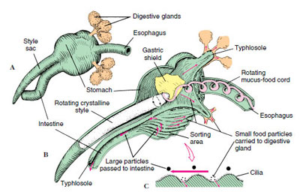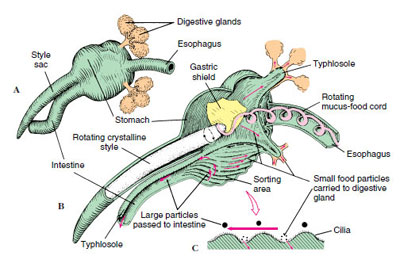
Eastern Oysters were once abundant in Barnegat Bay. Due to over harvesting and disease their numbers have been significantly reduced.
Oyster Anatomy Food Intake and Digestion
Eastern Oyster Crassostrea virginica
Oysters filter by drawing in water (inhatant) from the ventral side over their gills through the movement of cilia and current enhanced by the expulsion waste and water on the dorsal side.
Whatever is in the surrounding water is drawn in including phytoplankton (food) and phytoplankton (non-food) as well as zooplankton, silt, gravel, decayed plant and animal matter.
Grooves and cilia of the labial palps s are responsible for removing excess material and detritus from the food tracts of the gills.
Gills together with the mantle are the principal organs of respiration.
Oysters, as well as other bivalve mollusks depend strongly on ciliary action, rather than muscular contraction, to move food through their digestive tracts.
This is important in part because ciliary action is capable of sorting particles according to size and other features.
A second major difference is that in many bivalves, digestion is primarily intracellular (functioning within a cell)
The cilia of the gills are organized by three functional tracts and particles directed to:
Oral acceptance tracts are passed to the mouth
Rejection tracts are expelled from the oyster as pseudofeces
Resorting tracts are recirculated through the process. The resorting tracts serve as a means of volume control for the other tracts.
Stomach:
Particles which enter the digestive tract pass through the esophagus and into the stomach.
The stomach secretes a crystalline style, a gel comprised of digestive proteins and structural sugars.
The style is secreted by the style sac but is not itself a permanent structure.
The stomach wall also secretes digestive enzymes, even when the organism is not feeding.
Crystalline Style: 
and expelled as feces or pseudofeces.
Feces is waste that has passed through the digestive system. Pseudofeces is excess material and detritus rejected by the gills and/or the labial palps.
Crystalline Style image
and expelled as feces or pseudofeces.
Feces is waste that has passed through the digestive system. Pseudofeces is excess material and detritus rejected by the gills and/or the labial palps.
sters are bivalves, meaning that they have a shell consisting of two halves, or valves.
The valves are joined at the top, and a single adductor muscle in the center hold the shell closed.
When the adductor muscle is relaxed, the shell is pulled open by ligaments.
Oysters are filter feeders, drawing water in over their gills through the beating of cilia.
Suspended plankton and particles are trapped in mucus produced by the gills and then transported to the mouth, where they are eaten, digested, and expelled as feces or pseudofeces.
Feces is waste that has passed through the digestive system. Pseudofeces is excess material and detritus rejected by the gills and/or the labial palps.
Oysters produce strong pulsatile flow under unfavorable feeding conditions, during which they gather material selected for rejection, create a strong jet, and expel it from the pallial cavity(mantle) as pseudofeces.
The Digestive Process
Intake: the valves are opened and water is drawn in on the ventral side to the gills by movement of cilia and current enhanced by the expulsion of waste and clean water on the dorsal side.
The stomach secretes a crystalline style, a small rod comprised of digestive proteins and structural sugars.
Credits



